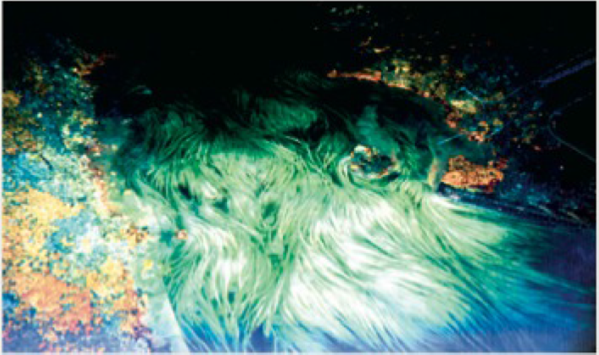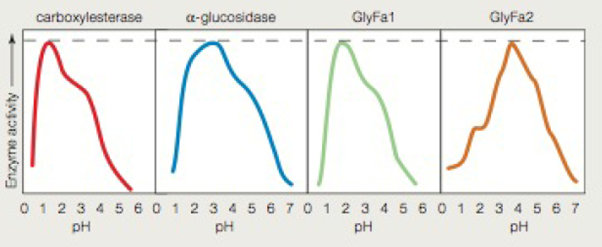
Concept explainers
One Tough Bug The genus Ferroplasma consists of a few species or acid-loving archaea. One species, F. acidarmanus, was discovered to be the main constituent of slime streamers (a type of biofilm) deep inside- an abandoned California copper mine (FIGURE 5.36). These cells use an ancient energy-harvesting pathway that combines oxygen with iron-sulfur compounds in minerals such as pyrite. Oxidizing these minerals dissolves them, so groundwater that seeps in to the mine ends up with extremely high concentrations of metal ions such as copper, zinc, cadmium, and arsenic. The reaction also produces sulfuric acid, which Lowers the pH of the water around the cells to zero.
F. acidarmanus cells maintain their internal pH at a cozy 5.0 despite living in an environment similar to hot battery acid. Thus, researchers investigating Ferroprasma were surprised to discover that most of the cells' enzymes function best at very low pH (FIGURE 5 .37).

FIGURE 5.36 Deep inside one of the most toxic sites in the United States:
Iron Mountain Mine, in California. The water in this Stream, which is about 1 meter (3 feet) wide in this view, is hot (around 40°C, or 104°F), heavily laden with arsenic and other toxic metals, and has a pH of zero. The slime streamers growing in it are a biofilm dominated by a species of archaea Ferropiasma acidarmanus.

FIGURE 5.37 pH anomaly of Ferroplasma acidarmanus enzymes. The graphs (right) show the pH activity profiles of four enzymes isolated from Ferroplasma. Researchers had expected these enzymes to function best at the cells' cytoplasmic pH (5.0).
3. What is the optimal pH for ferroplasma carboxylesterase?
Want to see the full answer?
Check out a sample textbook solution
Chapter 5 Solutions
Bundle: Biology: The Unity and Diversity of Life, 14th + LMS Integrated for MindTap Biology, 1 term (6 months) Printed Access Card
- O Macmillan Learning Glu-His-Trp-Ser-Gly-Leu-Arg-Pro-Gly The pKa values for the peptide's side chains, terminal amino groups, and carboxyl groups are provided in the table. Amino acid Amino pKa Carboxyl pKa Side-chain pKa glutamate 9.60 2.34 histidine 9.17 1.82 4.25 6.00 tryptophan 9.39 2.38 serine 9.15 2.21 glycine 9.60 2.34 leucine 9.60 2.36 arginine 9.04 2.17 12.48 proline 10.96 1.99 Calculate the net charge of the molecule at pH 3. net charge at pH 3: Calculate the net charge of the molecule at pH 8. net charge at pH 8: Calculate the net charge of the molecule at pH 11. net charge at pH 11: Estimate the isoelectric point (pl) for this peptide. pl:arrow_forwardBiology Questionarrow_forwardThis entire structure (Pinus pollen cone) using lifecycle terminology is called what?arrow_forward
- This entire structure using lifecycle terminology is called what? megastrobilus microstrobilus megasporophyll microsporophyll microsporangium megasporangium none of thesearrow_forwardHow much protein should Sarah add to her diet if she gets pregnant? Sarah's protein requirements during pregnancy would be higher. See Hint B2. During calculations, use numbers rounded to the first decimal place. In your answer, round the number of grams to the nearest whole number. _______ g ?arrow_forwardC MasteringHealth MasteringNu X session.healthandnutrition-mastering.pearson.com/myct/itemView?assignment ProblemID=17396422&attemptNo=1&offset=prevarrow_forwardMost people, even those who exercise regularly at low to average intensity (1 hour at the gym or a 2- to 3-mile walk several times per week), do not need an increased protein intake. What would be the protein needs of a man named Josh who exercises moderately and is the same age and size as Wayne? Josh is 5 ft, 8 in tall and weighs 183 lb. Round the number of grams to the nearest whole number. During calculations, use numbers rounded to the first decimal place. Because protein requirement is a range, please enter two numbers: lower and upper range values, respectively. Separate the lower and upper range values, in that order, by a comma. ___, ___ g ?arrow_forwardC MasteringHealth MasteringNu X session.healthandnutrition-mastering.pearson.com/myct/itemView?assignment ProblemID=17396422&attemptNo=1&offset=prevarrow_forwardIf left untreated, most HIV-infected individuals will develop AIDS. Current treatments are focused on highlyactive antiretroviral therapy (HAART). HAART usually consists of an orally delivered drug cocktail containingtwo different reverse transcriptase inhibitors and one other drug, such as a protease inhibitor. Question: Develop a pharmacokinetic model of HAART treatment. Consider all 3 drugs. Make sure to include adiagram that illustrates your thinking, state all assumptions, and define your variables. Whatparameters would you need to know to find the concentration of drug in the plasma? In the T cells?(You do not need to write out or solve any equations.)arrow_forwardnot use ai pleseaarrow_forward(A) 25 20 20 15 NPP (Mg C/ha/yr) 10 10 5 0 0 2,000 4,000 6,000 ECOLOGY 4e, Figure 20.11 (Part 1) 2017 Sinauer Associates, Inc. Average annual precipitation (mm) 8,000arrow_forwardexplain the cascade of events (starting with relaxing trade winds) that occurs during El Niño in the eastern Pacific (off the coasts of California/North America and Peru/South America) and which lead to food-chain collapse - start with changes in the physical/oceanographic conditions, andthen systematically describe the cascading effects at each level of the food chain -arrow_forwardarrow_back_iosSEE MORE QUESTIONSarrow_forward_iosRecommended textbooks for you
 Biology Today and Tomorrow without Physiology (Mi...BiologyISBN:9781305117396Author:Cecie Starr, Christine Evers, Lisa StarrPublisher:Cengage Learning
Biology Today and Tomorrow without Physiology (Mi...BiologyISBN:9781305117396Author:Cecie Starr, Christine Evers, Lisa StarrPublisher:Cengage Learning BiochemistryBiochemistryISBN:9781305577206Author:Reginald H. Garrett, Charles M. GrishamPublisher:Cengage Learning
BiochemistryBiochemistryISBN:9781305577206Author:Reginald H. Garrett, Charles M. GrishamPublisher:Cengage Learning Concepts of BiologyBiologyISBN:9781938168116Author:Samantha Fowler, Rebecca Roush, James WisePublisher:OpenStax College
Concepts of BiologyBiologyISBN:9781938168116Author:Samantha Fowler, Rebecca Roush, James WisePublisher:OpenStax College Biology: The Dynamic Science (MindTap Course List)BiologyISBN:9781305389892Author:Peter J. Russell, Paul E. Hertz, Beverly McMillanPublisher:Cengage Learning
Biology: The Dynamic Science (MindTap Course List)BiologyISBN:9781305389892Author:Peter J. Russell, Paul E. Hertz, Beverly McMillanPublisher:Cengage Learning
 Biology Today and Tomorrow without Physiology (Mi...BiologyISBN:9781305117396Author:Cecie Starr, Christine Evers, Lisa StarrPublisher:Cengage Learning
Biology Today and Tomorrow without Physiology (Mi...BiologyISBN:9781305117396Author:Cecie Starr, Christine Evers, Lisa StarrPublisher:Cengage Learning BiochemistryBiochemistryISBN:9781305577206Author:Reginald H. Garrett, Charles M. GrishamPublisher:Cengage Learning
BiochemistryBiochemistryISBN:9781305577206Author:Reginald H. Garrett, Charles M. GrishamPublisher:Cengage Learning Concepts of BiologyBiologyISBN:9781938168116Author:Samantha Fowler, Rebecca Roush, James WisePublisher:OpenStax College
Concepts of BiologyBiologyISBN:9781938168116Author:Samantha Fowler, Rebecca Roush, James WisePublisher:OpenStax College Biology: The Dynamic Science (MindTap Course List)BiologyISBN:9781305389892Author:Peter J. Russell, Paul E. Hertz, Beverly McMillanPublisher:Cengage Learning
Biology: The Dynamic Science (MindTap Course List)BiologyISBN:9781305389892Author:Peter J. Russell, Paul E. Hertz, Beverly McMillanPublisher:Cengage Learning
